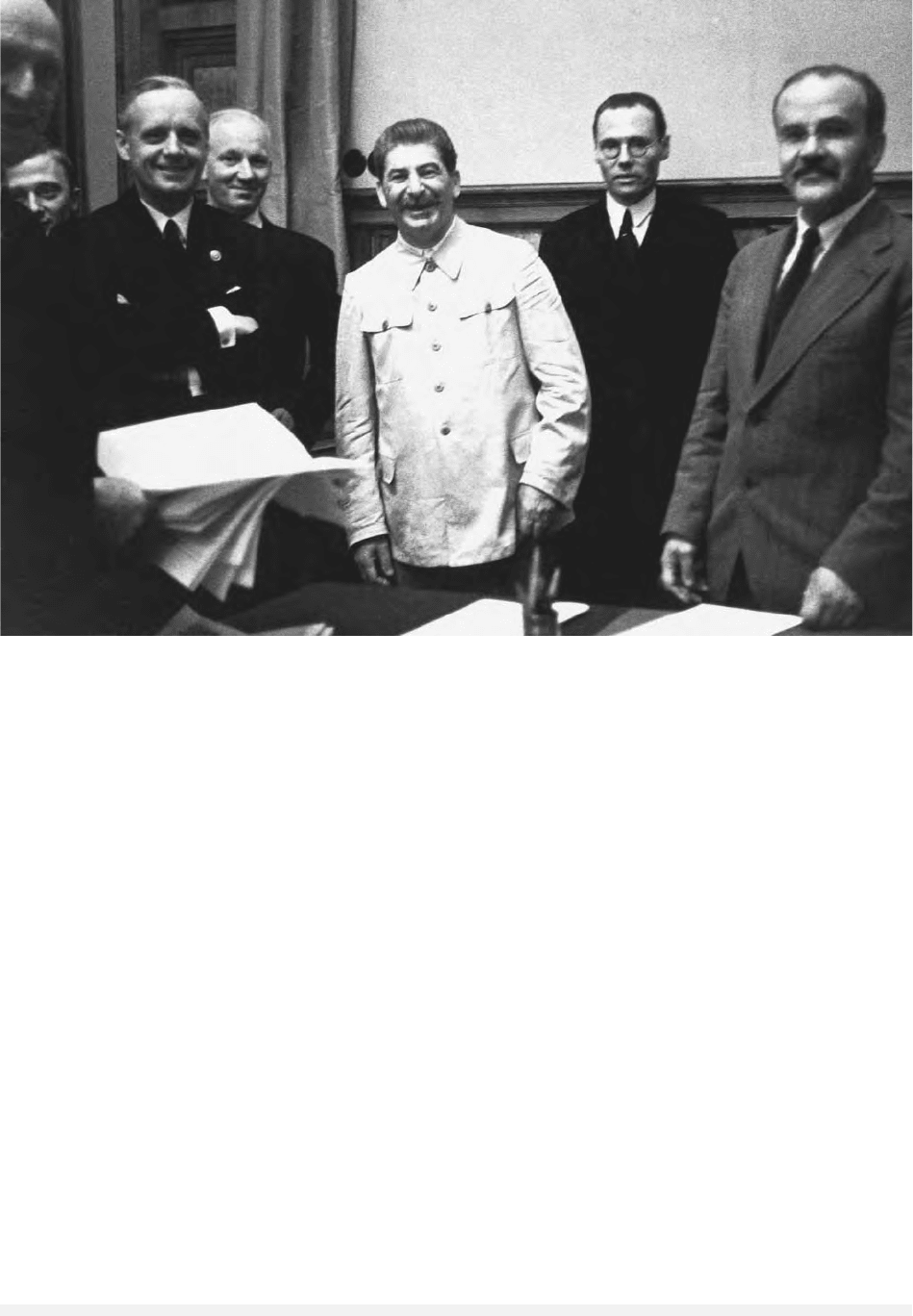Encyclopedia of Russian History
Подождите немного. Документ загружается.


disloyalty. During the reign of Alexander III
(1881–1894) a policy of standardization and ad-
ministrative and cultural Russification was initi-
ated in the Baltic provinces and provoked the
resistance of the Baltic Germans. During the 1890s
Finland became the object of the policy of forceful
integration, which unleashed national mobilization
not only of the old Swedish-speaking elite, but of
the broad Finnish masses. From 1881 on, the gov-
ernment enforced discriminatory measures against
Jews, who were suspected of being revolutionaries
and traitors and who were scapegoated. Anti-
Semitism became an important part of Russian in-
tegral nationalism, although the tsarist govern-
ment did not organize the anti-Jewish pogroms of
1881 and of 1903 to 1906. In Transcaucasia from
the 1870s Russification measures alienated the
Georgian noble elite and, after the 1880s, the Ar-
menian Church and middle class.
In the last third of the nineteenth century, the
tsarist government renounced cooperation with
most of the co-opted loyal nobilities (Poles, Baltic
Germans, Finlanders, Georgians) and loyal middle
classes (Jews, Armenians). With the rise of ethnic
nationalism and growing tensions in foreign pol-
icy, loyalty was expected only from members of
the Russian nation and not from non-Russian elites,
who were regarded with growing suspicion. On the
whole the repressive measures against non-Rus-
sians in the western and southern periphery had
counterproductive results, strengthening national
resistance and enlarging national movements.
However, the tsarist policy toward most of the
ethnic groups of the East remained basically un-
changed. It is true that state and church tried
to strengthen Orthodox faith and “Russianness”
among the Christianized peoples of the Volga-
Ural-Region, but the so-called Ilminsky system,
which introduced native languages into mission-
ary work, was above all a defensive measure
against the growing appeal of Islam. By creating
literary languages and native-language schools for
many small ethnic groups, it furthered in the long
run their cultural nationalism. In the last fifty
years of tsarism, there were only cautious mis-
sionary activities and virtually no Russificatory
measures among the Muslims of the empire.
In 1905 peasants and workers in the western
and southern peripheries were the most active
promoters of the revolution. The revolution un-
leashed a short “spring of nations” that embraced
nearly all ethnic groups of the empire. The removal
of most political and some cultural restrictions and
the possibility of political participation in the first
two State Dumas (1906–1907) caused widespread
national mobilization. Although the tsarist gov-
ernment soon afterward restricted individual and
collective liberties and rights, it could not return to
the former policy of repression and Russification.
The violent insurrections of Latvian, Estonian, and
Georgian peasants and of Polish, Jewish, Latvian,
and Armenian workers made clear that turning
away from cooperation with the regional elites had
proved to be dangerous for social and political sta-
bility. The tsarist government tried to split non-
Russians by a policy of divide and rule and partially
returned to the coalition with loyal, conservative
forces among non-Russians. On the other hand it
was influenced by the rising ethnic Russian na-
tionalism, which was used to integrate Russian so-
ciety and to bridge its deep social and political
cleavages. Despite the many unresolved political,
social, economic, and ethno-national problems, the
government managed to hold together the hetero-
geneous empire until 1917. The national questions
were not among the main causes for the collapse
of the tsarist regime in February 1917, but they
became crucial for the dissolution of the empire af-
ter October 1917.
See also: ILMINSKY, NIKOLAI IVANOVICH; NATIONALISM
IN THE TSARIST EMPIRE; NATIONALITIES POLICIES, SO-
VIET; NATION AND NATIONALITY; OFFICIAL NATION-
ALITY; RUSSIFICATION; SLAVOPHILES
BIBLIOGRAPHY
Allworth, Edward, ed. (1998). Central Asia: 130 Years of
Russian Dominance, A Historical Overview. Durham,
NC: Duke University Press.
Brower; Daniel (2003). Turkestan and the Fate of the Russ-
ian Empire. London, NY: Routledge Curzon.
Brower, Daniel R., and Lazzerini, Edward J., eds. (1997).
Russia’s Orient: Imperial Borderlands and Peoples,
1700-1917. Bloomington: Indiana University Press.
Forsyth, James. (1992). A History of the Peoples of Siberia:
Russia’s North Asian Colony, 1581-1990. Cambrige,
UK: Cambridge University Press.
Geraci, Robert P., and Khodarkovsky, Michael, eds.
(2001). Of Religion and Empire: Missions, Conversion,
and Tolerance in Tsarist Russia. Ithaca, NY: Cornell
University Press.
Geyer, Dietrich. (1987). Russian Imperialism. New Haven,
CT: Yale University Press.
Hosking, Geoffrey. (1997). Russia: People and Empire.
London: HarperCollins.
Kappeler, Andreas. (2001). The Russian Empire: A Multi-
ethnic History. Harlow, UK: Longman.
NATIONALITIES POLICIES, TSARIST
1023
ENCYCLOPEDIA OF RUSSIAN HISTORY

Kappeler, Andreas, Kohut, Zenon E., et al, eds. (2003).
Culture, Nation, and Identity: The Ukrainian–Russian
Encounter, 1600–1945. Toronto: CIUS Press.
Khodarkovsky, Michael (2002). Russia’s Steppe Frontier.
The Making of a Colonial Empire, 1500–1800. Bloom-
ington: Indiana University Press.
Klier, John Doyle. (1986). Russia Gathers Her Jews: The
Origins of the “Jewish Question” in Russia, 1772–1825.
Dekalb: Northern Illinois Press.
Kohut, Zenon E. (1988). Russian Centralism and Ukrain-
ian Autonomy: Imperial Absoprtion of the Hetmanate,
1760s–1830s. Cambridge, MA: Harvard University
Press.
Lantzeff, George V., and Pierce, Richard A. (1973). East-
ward to Empire: Exploration and Conquest on the Russ-
ian Open Frontier, to 1750. Montreal: McGill–Queens
University Press.
Lieven, Dominic. (2000). Empire: The Russian Empire and
Its Rivals. London: John Murray.
Loewe, Heinz–Dietrich. (1993). The Tsars and the Jews:
Reform, Realism, and Anti–Semitism in Imperial Rus-
sia, 1772–1917. Chur, Switzerland: Harwood Acad-
emic Publications.
Raeff, Marc. (1971). “Patterns of Russian Imperial Pol-
icy Toward the Nationalities.” In Soviet Nationality
Problems, ed. Edward Allworth. New York: Colum-
bia University Press.
Riasanovsky, Nicholas V. (1959). Nicholas I and Official
Nationality in Russia, 1825–1855. Berkeley: Univer-
sity of California Press.
Rogger, Hans. (1986). Jewish Policies and Right–Wing Pol-
itics in Imperial Russia. Berkeley: University of Cal-
ifornia Press.
Rywkin, Michael, ed. (1988). Russian Colonial Expansion
to 1917. London: Mansell Publishing Ltd.
Saunders, David. (2000). “Regional Diversity in the Later
Russian Empire.” Transactions of the Royal Historical
Society 6(10):143–163.
Starr, S. Frederick. (1978). “Tsarist Government: The Im-
perial Dimension.” In Soviet Nationality Policies and
Practices, ed. Jeremy R. Azrael. New York: Praeger.
Suny, Ronald Grigor, ed. (1983). Transcaucasia. Nation-
alism and Social Change: Essays in the History of
Armenia, Azerbaijan, and Georgia. Ann Arbor: Uni-
versity of Michigan Press.
Thaden, Edward C., ed. (1981). Russification in the Baltic
Provinces and Finland, 1855–1914. Princeton, NJ:
Princeton University Press.
Thaden, Edward C., with the collaboration of Marianna
Forster Thaden. (1984). Russia’s Western Borderlands,
1710–1870. Princeton, NJ: Princeton University
Press.
Tillett, Lowell. (1969). The Great Friendship: Soviet Histo-
rians on the Non-Russian Nationalities. Chapel Hill:
University of North Carolina Press.
Vucinich, Wayne S., ed. (1972). Russia and Asia: Essays
on the Influence of Russia on the Asian Peoples. Stan-
ford, CA: Stanford University Press.
Weeks, Theodore R. (1996). Nation and State in Late Im-
perial Russia: Nationalism and Russification on the
Western Frontier, 1863–1914. De Kalb: Northern Illi-
nois University Press.
A
NDREAS
K
APPELER
NATION AND NATIONALITY
The concepts of nation and nationality are ex-
tremely difficult to define. According to one im-
portant view, a nation is a sovereign people—a
voluntary civic community of equal citizens; ac-
cording to another, a nation is an ethnic commu-
nity bound by common language, culture, and
ancestry. Civic nations and ethnic nations as de-
fined here are ideals that do not exist in reality, for
most nations combine civic and ethnic characteris-
tics, and either civic or ethnic features may pre-
dominate in any given community. In national
communities where citizenship is seen as a major
unifying force, the term nationality usually denotes
citizenship; in nations whose unity rests largely on
common culture and ancestry, nationality gener-
ally refers to ethnic origin.
There is little agreement about the balance be-
tween ethnic and civic components within nations,
or between subjective characteristics, such as mem-
ory and will, and objective elements, such as com-
mon language or territory. Most scholars hold that
nations are modern sociopolitical constructs, by-
products of an industrializing society. But the na-
ture of the links between modern nations and
earlier types of communities (e.g., premodern eth-
nic groups) is hotly contested.
Several definitions of nation have existed in
Russia since the late eighteenth century, and there
was no serious effort to regularize the terminology
for discussing the issue of nationality until the
1920s and 1930s. Although the concept of nation
was developed in Western Europe and was not ap-
plicable to Russia for much of the nineteenth cen-
tury, the question of what constituted a nation and
nationality were debated passionately.
NATION AND NATIONALITY
1024
ENCYCLOPEDIA OF RUSSIAN HISTORY

PREREVOLUTIONARY PERIOD
In the prerevolutionary period, several different
words were used in intellectual and political dis-
cussions of what constituted a nation in the con-
text of the Russian Empire: narod, narodnost,
natsionalnost, natsiya, and plemya. Despite some ef-
forts to differentiate these terms, they were gener-
ally used interchangeably.
In the 1780s and the 1790s, under the impact
of the Enlightenment and the French Revolution, a
few liberal Russian intellectuals began to use the
word narod (people) in the meaning most closely
approximating the French definition of a nation as
a sovereign people. For literary figures like Nikolai
Novikov and Alexander Radishchev, nobility and
peasantry were united in the narod. They recog-
nized, of course, that such a community was not
a reality in Russia but an ideal to be achieved some-
day. Liberal periodicals of the time proudly printed
the word with a capital N. The understanding of
narod as referring only to the peasantry was a later
invention of the so-called Slavophiles of the 1830s
and the 1840s, whose ideas were strongly influ-
enced by German Romanticism, which held that
folk tradition was the embodiment of the spirit of
the nation. The Slavophiles also explicitly separated
and juxtaposed the narod and the upper classes,
whom they termed “society” (obshchestvennost), ar-
guing that society, because Europeanized, was cut
off from the indigenous national tradition.
In 1819, the poet Peter Vyazemsky coined the
term narodnost in reference to national character.
A search for manifestations of narodnost in litera-
ture, art, and music began. In 1832, the govern-
ment responded to this growing interest in the
national question by formulating its own view of
Russia’s essential characteristics. The future minis-
ter of enlightenment, Count Sergei Uvarov, stated
that the three pillars of Russia’s existence were Or-
thodoxy, Autocracy, and Nationality (narodnost,
i.e., national character manifested in the folk tra-
dition).
Whereas the Slavophiles looked for manifesta-
tions of narodnost in Orthodox Christianity and
peasant culture, the Westernizer and literary critic
Vissarion Belinsky insisted, in the 1840s, that the
educated classes—the product of Peter the Great’s
Europeanizing policies—were the bearers of a mod-
ern national tradition. Belinsky was thus arguing
against the Slavophiles as well as Uvarov. He also
offered a more precise definition of the words used
to describe nation and nationality. For him, naro-
dnost referred to a premodern stage in people’s de-
velopment, whereas nationalnost and natsiya de-
scribed superior developmental stages. Belinsky
concluded that “Russia before Peter the Great had
only been a narod [people] and became a natsiya
[nation] as a result of the impetus which the re-
former had given her” (Kara-Murza and Poliakov
1994, p. 25).
Other authors adopted Belinsky’s distinction
between narod and natsiya, but the interchange-
able usage prevailed. Even the word plemya (tribe),
which in the twentieth century was applied to
primitive communities, often meant a nation in the
nineteenth. Thus, in the 1870s and the 1880s,
politicians and intellectuals justified government
policies of linguistic Russification in the imperial
borderlands by referring to the national consolida-
tion of “the French and German tribes.” Nor did Be-
linsky’s search for Russian national tradition in the
Europeanized culture of the educated classes have
a significant following. Instead, the exclusion of the
upper classes from the narod by the early Slavo-
philes was further developed by the writer and so-
cialist thinker Alexander Herzen in the late 1840s
and the early 1850s and by members of the pop-
ulist movement in the 1870s. After the February
Revolution of 1917, in the discourse of elites as
well as in popular usage, the upper classes, termed
burzhui (the bourgeoisie), were excluded from the
nation.
The concepts of nation and nationality began
to influence tsarist government policies around the
time of Alexander II’s reforms in the 1860s. At the
turn of the twentieth century, the government be-
gan to use the language-based idea of nationality
(narodnost), rather than religion, as a criterion to
distinguish Russians from non-Russians and to dif-
ferentiate different groups of non-Russians. Naro-
dnost based on language was one of the categories
in the all-Russian census of 1897.
The question of how to define the boundaries
and membership of a nation or nationality was as
much debated by intellectuals, scholars, and gov-
ernment officials in the late nineteenth and the early
twentieth centuries as it is in the early twenty-first
century. The bibliographer Nikolai Rubakin’s sur-
vey of the debate on the national question in Rus-
sia and Europe (1915) divided the definitions of
a nation into three categories: psychological—
nations are defined by a subjective criterion, such
as the will to belong voluntarily to the same com-
munity, as exemplified by the French tradition;
empirical—nations are defined by objective charac-
teristics, such as language, customs, common his-
NATION AND NATIONALITY
1025
ENCYCLOPEDIA OF RUSSIAN HISTORY

tory, sometimes common religion and laws, as
exemplified by the German tradition; and economic
materialist—nations are a modern construct typ-
ical of capitalism, as maintained by Marxists.
Rubakin also separately mentioned two other de-
finitions, one equating nation and state, and the
other defining nation racially as a community of
individuals related by blood. In his view, all of the
definitions, except for the psychological one, were
expounded in the writings of Russian thinkers.
The most influential of them were the concept of
nationality based on language and the view that
the Europeanized upper classes did not rightfully
belong to the national community.
SOVIET PERIOD
How nation and nationality were defined became
exceedingly important in the Soviet period, because,
from the earliest days of the communist regime,
nationality became a central category of policy-
making for the new government. The founders of
the Soviet state, Vladimir Lenin and Josef Stalin,
followed Karl Marx’s perception of nations as his-
torically contingent and modern rather than pri-
mordial communities. In 1913, Stalin affirmed that
“a nation is not racial or tribal, but a historically
constituted community of people” (Hutchinson and
Smith 1994, p. 18). Yet the Soviet leaders admit-
ted the reality of nations and recognized their as-
piration for self-determination. Although Lenin and
Stalin followed Marx’s belief in the eventual disap-
pearance of nations in the post-capitalist world,
they accepted that nations would continue to exist
for some time and that their aspirations would need
to be satisfied during the construction of socialism.
In an unprecedented experiment, the Bolshevik gov-
ernment institutionalized ethnoterritorial federal-
ism, classified people according to their ethnic
origins, and distributed privileges as well as pun-
ishments to different ethnically defined groups.
These policies required criteria for defining na-
tions and nationalities more specific than those in
effect before the October Revolution. The new cri-
teria were developed in the 1920s and 1930s in
preparation for the all-union censuses of 1926,
1937, and 1939. In 1913, Stalin had described a
nation (natsiya) as “a stable community of people,
formed on the basis of a common language, terri-
tory, economic life, and psychological make-up
manifested in a common culture” (Hutchinson and
Smith 1994, p. 20). In the 1920s, it became ap-
parent that the application of this definition would
exclude certain distinct groups from being recog-
nized and recorded in the census. Therefore, in 1926
the less precise category of narodnost was accepted
for the census. Given that various groups were seen
as denationalized (i.e., they used Russian rather
than the original native language of their commu-
nity), a narodnost could also be defined by cus-
toms, religious practices, and physical type. At the
same time, people’s self-definitions in relation to
nationality were taken into account. By 1927, 172
nationalities had received official status in the
USSR. Policies aimed at satisfying their “national
aspirations” were central to the communist recon-
struction of society.
In the 1930s, the number of officially recog-
nized nationalities was drastically reduced, on the
grounds that the adoption of the narodnost cate-
gory had allowed too many groups to receive of-
ficial recognition. The 1937 and 1939 censuses used
a different category, nationality (nationalnost); in
order to qualify for the status of natsionalnost,
communities had not only to possess a distinct cul-
ture and customs but also to be linked to a terri-
tory and demonstrate “economic viability.” In turn,
narodnost began to refer only to smaller and less
developed communities. By 1939, a list of fifty-
nine major nationalities (glavnye natsionalnosti)
was produced.
In an another important development, the
1930s were marked by a departure in official dis-
course from the view of nations as modern con-
structs toward an emphasis on their primordial
ethnic roots. This development was a result of the
government’s “extreme statism.” By using socio-
logical categories as the basis for organizing, clas-
sifying, and rewarding people, the communists
were obliged to treat as concrete realities factors
that, as they themselves recognized, were actually
artificial constructs. This approach, in which na-
tionality was not a voluntary self-definition but a
“given” determined by birth, culminated in the in-
troduction of the category of “nationality” (mean-
ing not citizenship but ethnic origin inherited from
parents) in Soviet passports in 1932.
The view of nations as primordial ethnic com-
munities was reinforced in the 1960s and 1970s
by the new theory of the “ethnos,” defined by the
Soviet ethnographer Yuly Bromlei as “a historically
stable entity of people developed on a certain terri-
tory and possessing common, relatively stable fea-
tures of culture . . . and psyche as well as a
consciousness of their unity and of their difference
from other similar entities” (Tishkov 1997, p. 3).
For Bromlei, the ethnos attains its highest form in
NATION AND NATIONALITY
1026
ENCYCLOPEDIA OF RUSSIAN HISTORY

the nation. Only communities with their own
union or autonomous republics were considered so-
cialist nations.
The same period was marked by a debate about
the “Soviet narod,” whose existence as a fully
formed community was postulated by Leonid
Brezhnev in 1974. The Soviet narod was defined as
the historical social unity of the diverse Soviet na-
tionalities rather than a single nation. Some ethno-
graphers claimed, however, that a united nation
with one language was being created in the USSR.
In the post-communist period, the view of na-
tions as primordial ethnosocial communities con-
tinued to be strong. Also widespread was the
perception that only one nation can have a legiti-
mate claim on any given territory. Views of this
kind are at the root of the ethnic conflicts in the
post-Soviet space. At the same time, a competing
definition of the nation as a voluntary civic com-
munity of equal citizens, regardless of ethnic
origin, is gathering strength. Constitutions and cit-
izenship laws in the newly independent states of
the former USSR reflect the tensions between these
conflicting perceptions of nationhood.
See also: ENLIGHTENMENT, IMPACT OF; ETHNOGRAPHY,
RUSSIAN AND SOVIET; LANGUAGE LAWS; NATIONALI-
TIES POLICIES, SOVIET; NATIONALITIES POLICIES,
TSARIST; SLAVOPHILES
BIBLIOGRAPHY
Hirsch, Francine. (1997). “The Soviet Union as a Work-
in-Progress: Ethnographers and the Category Na-
tionality in the 1926, 1937, and 1939 Censuses.”
Slavic Review 56 (2):251–278.
Hutchinson, John, and Smith, Anthony D., eds. (1994).
Nationalism. Oxford: Oxford University Press.
Kara-Murza, A., and Poliakov, L., eds. (1994). Russkie o
Petre I. Moscow: Fora.
Martin, Terry. (2000). “Modernization or Neo-Tradi-
tionalism? Ascribed Nationality and Soviet Primor-
dialism” In Stalinism: New Directions, ed. Sheila
Fitzpatrick. London: Routledge.
Suny, Ronald, and Martin, Terry, eds. (2001). A State of
Nations: Empire and Nation-Making in the Age of Lenin
and Stalin. New York: Oxford University Press.
Tishkov, Valery. (1997). Ethnicity, Nationalism and Con-
flict in and After the Soviet Union. London: Sage.
Tolz, Vera. (2001). Russia. New York: Oxford Univer-
sity Press.
V
ERA
T
OLZ
NATO See NORTH ATLANTIC TREATY ORGANIZATION.
NAVARINO, BATTLE OF
The Battle of Navarino on October 20, 1827, re-
sulted from a joint Anglo-French-Russian effort to
mediate the Greek–Ottoman civil war. The three
countries decided to intervene in the increasingly
brutal conflict, which had been raging since 1821,
and on October 1, 1827, British vice admiral Ed-
ward Codrington took command of a combined
naval force. Codrington ordered his squadron to
proceed to Navarino Bay on the southwestern coast
of the Peloponnese, where an Ottoman-Egyptian
fleet of three ships of the line, twenty-three frigates,
forty-two corvettes, fifteen brigs, and fifty trans-
ports under the overall command of Ibrahim Pasha
was moored.
Before entering the bay, the allied commanders
sent Ibrahim an ultimatum demanding that he
cease all operations against the Greeks. Ibrahim was
absent, but his officers refused, and they opened
fire when the allies sailed into the bay on the morn-
ing of October 20. In the intense fighting that en-
sued, the Azov, the Russian flagship, was at one
point engaged simultaneously by five enemy ves-
sels. Commanded by Mikhail Petrovich Lazarev, the
Azov sank two frigates and damaged a corvette. The
battle was over within four hours. The Ottoman-
Egyptian fleet lost all three ships of the line along
with twenty-two frigates and seven thousand
sailors. Only one battered frigate and fifteen small
cruisers survived. The Russian squadron left fifty-
nine dead and 139 wounded.
In the aftermath, the recriminations began al-
most immediately. The duke of Wellington, Britain’s
prime minister, denounced Codrington’s decision to
take action as an “untoward event.” From the
British standpoint, the annihilation of the Turkish-
Egyptian fleet was problematic, because it strength-
ened Russia’s position in the Mediterranean.
Shortly after the battle Codrington was recalled to
London. Tsar Nicholas I awarded the Cross of St.
George to Vice Admiral L. P. Geiden, the comman-
der of the Russian squadron, and promoted Lazarev
to rear admiral. The Azov was granted the Ensign
of St. George, which in accordance with tradition
would be handed down, over the generations, to
other vessels bearing the same name. The Russian
squadron recovered from the battle and repaired its
ships at Malta. During the Russo-Turkish War of
NAVARINO, BATTLE OF
1027
ENCYCLOPEDIA OF RUSSIAN HISTORY

1828 to 1829, Geiden took command of Rear Ad-
miral Peter Rikord’s squadron from Kronstadt. The
Russian fleet now numbered eight ships of the line,
seven frigates, one corvette, and six brigs. Geiden
and Rikord blockaded the Dardanelles and impeded
Ottoman-Egyptian operations against the Greeks.
After the war’s end, Geiden’s squadron returned to
the Baltic.
See also: GREECE, RELATIONS WITH; RUSSO-TURKISH WARS
BIBLIOGRAPHY
Anderson, Roger Charles (1952). Naval Wars in the Lev-
ant, 1559–1853. Princeton, NJ: Princeton University
Press.
Daly, John C. K. (1991). Russian Seapower and the “East-
ern Question,” 1827–1841. London: Macmillan.
Daly, Robert Welter. (1959). “Russia’s Maritime Past.”
In The Soviet Navy, ed. Malcolm G. Saunders. Lon-
don: Weidenfeld & Nicolson.
Woodhouse, Christopher Montague. (1965). The Battle of
Navarino. London: Hoddler & Stoughton.
J
OHN
C. K. D
ALY
NAVY See BALTIC FLEET; BLACK SEA FLEET; MILITARY, IM-
PERIAL ERA; MILITARY, SOVIET AND POST-SOVIET;
NORTHERN FLEET; PACIFIC FLEET.
NAZARBAYEV, NURSULTAN ABISHEVICH
(b. 1940), Communist Party, Soviet, and Kazakh
government official.
Born into a rural family of the Kazakh Large
Horde in the Alma-Ata region, Nursultan Abishe-
vich Nazarbaev finished technical school in 1960,
attended a higher technical school from 1964 to
1967, and married Sara Alpysovna, an agronomist-
economist. He joined the Communist Party (CPSU)
in 1962, began working in both the Temirtau City
Soviet and Party Committee in 1969, and advanced
rapidly thereafter. In 1976 he graduated from the
external program of the CPSU Central Committee’s
Higher Party School, and from 1977 to 1979 he
led the Party’s Karaganda Committee. Nazabayev’s
abilities as a “pragmatic technocrat,” and the sup-
port of such patrons as the Kazakh Party’s pow-
erful first secretary Dinmukhammed Kunayev and
Mikhail Andreyevich Suslov and Yuri Vladimirovich
Andropov in Moscow ensured his election as a sec-
retary of the Kazakh Central Committee in 1979,
to the Soviet Party’s Central Auditing Commission
from 1981 to 1986, to chairmanship of the Kazakh
SSR’s Council of Ministers in 1984, and to the CPSU
Central Committee in March 1986.
In the riots following Kunaev’s ouster in De-
cember 1986, Nazarbayev sought to control stu-
dent demonstrators. Rather than harming his career,
his stance won him considerable support among
Kazakh nationalists, and loyalty to Mikhail Gor-
bachev ensured his place on the Soviet Central Com-
mittee. Elected to the new Congress of People’s
Deputies, he quickly became the Kazakh Party’s
first secretary when ethnic riots again broke out in
June 1989. From February 1990 he also was chair-
man of the Kazakh Supreme Soviet, which elected
him the Kazakh SSR’s president in April. He joined
the Soviet Politburo in that July but, after briefly
temporizing during the August 1991 putsch, left
the Soviet Party the following September. He
presided over the Kazakh Party’s dissolution in Oc-
NAVY
1028
ENCYCLOPEDIA OF RUSSIAN HISTORY
Nursultan Nazarbayev, president of independent Kazakhstan.
H
ULTON
/A
RCHIVE
. R
EPRODUCED BY PERMISSION
.

tober, and then won a massive electoral victory on
December 1, 1991. As president, Nazarbaev over-
saw formation of an independent Republic of Kaza-
khstan and its entry into the Commonwealth of
Independent States (CIS). Despite deep ethnic, reli-
gious, and linguistic divisions; continuing economic
crisis; Russian neglect; and bitter political disputes
within the elite, he maintained Kazakhstan’s unity
and position within the CIS. To this end he replaced
the parliament with a People’s Assembly in 1995,
and a referendum extended his term until 2000.
Surprising the opposition by calling new elections,
Nazarbaev became virtual president-for-life in
January 1999 and, with his family dynasty, dom-
inates a powerful cabinet regime that often con-
strains, but has not abolished, Kazakh civil liberties.
See also: COMMUNIST PARTY OF THE SOVIET UNION;
KAZAKHSTAN AND KAZAKHS; NATIONALITIES POLI-
CIES, SOVIET
BIBLIOGRAPHY
Bremmer, Ian, and Taras, Ray. (1997). New Politics:
Building the Post-Soviet Nations. Cambridge, UK:
Cambridge University Press.
Olcott, Martha Brill. (1995). The Kazakhs, 2nd ed. Stan-
ford, CA: Hoover Institution.
Olcott, Martha Brill. (2000). Kazakhstan: Unfilled
Promise. Washington, DC: Carnegie Endowment for
International Peace.
Morozov, Vladimir, ed. (1995). Who’s Who in Russia and
the CIS Republics. New York: Henry Holt.
D
AVID
R. J
ONES
NAZI-SOVIET PACT OF 1939
The Nazi-Soviet Pact is the name given to the Treaty
of Non-Aggression signed by Ribbentrop for Ger-
many and Molotov for the USSR on August 23,
1939.
In August 1939, following the failure of at-
tempts to negotiate a treaty with Great Britain and
France for mutual assistance and military support
to protect the USSR from an invasion by Adolf
Hitler, the Soviet Union abandoned its attempts to
achieve collective security agreements, which was
the basis of Maxim Maximovich Litvinov’s foreign
policy during the 1930s. Instead, Soviet leaders
sought an accommodation with Germany. For Ger-
man politicians, the dismissal of Litvinov and the
appointment of Vyacheslav Mikhailovich Molotov
as commissar for foreign affairs on May 3, 1939,
was a signal that the USSR was seeking a rap-
prochement. The traditional interpretation that
Molotov was pro-German, and that his appoint-
ment was a direct preparation for the pact, has been
called into question. It seems more likely that in
appointing Molotov, Joseph Vissarionovich Stalin
was prepared to seize any opportunity that pre-
sented itself to improve Soviet security.
Diplomatic contact with Germany on eco-
nomic matters had been maintained during the ne-
gotiations with Great Britain and France, and in
June and July of 1939, Molotov was not indiffer-
ent to initial German approaches for an improve-
ment in political relations. On August 15, the
German ambassador proposed that Joachim von
Ribbentrop, the German foreign minister, should
visit Moscow for direct negotiations with Stalin
and Molotov, who in response suggested a non-
aggression pact.
Ribbentrop flew to Moscow on August 23, and
the Treaty of Nonaggression was signed in a few
hours. By its terms the Soviet Union and Germany
undertook not to attack each other either alone or
in conjunction with other powers and to remain
neutral if the other power became involved in a war
with a third party. They further agreed not to par-
ticipate in alliances aimed at the other state and to
resolve disputes and conflicts by consultation and
arbitration. With Hitler about to attack Poland, the
usual provision in treaties of this nature, allowing
one signatory to opt out if the other committed ag-
gression against a third party, was missing. The
agreement was for a ten–year period, and became
active as soon as signed, rather than on ratifica-
tion.
As significant as the treaty, and more notori-
ous, was the Secret Additional Protocol that was
attached to it, in which the signatories established
their respective spheres of influence in Eastern Eu-
rope. It was agreed that “in the event of a territo-
rial and political rearrangement” in the Baltic states,
Finland, Estonia, and Latvia were in the USSR’s
sphere of influence and Lithuania in Germany’s.
Poland was divided along the rivers Narew, Vis-
tula, and San, placing Ukrainian and Belorussian
territories in the Soviet sphere of influence, together
with a part of ethnic Poland in Warsaw and Lublin
provinces. The question of the maintenance of an
independent Poland and its frontiers was left open.
In addition, Germany declared itself “disinterested”
in Bessarabia.
NAZI-SOVIET PACT OF 1939
1029
ENCYCLOPEDIA OF RUSSIAN HISTORY

The treaty denoted the USSR’s retreat into
neutrality when Hitler invaded Poland on Septem-
ber 1, 1939, and Great Britain and France declared
war. Poland collapsed rapidly, but the USSR delayed
until September 17 before invading eastern Poland,
although victory was achieved within a week.
From November 1939, the territory was incorpo-
rated in the USSR. Estonia and Latvia were forced
to sign mutual assistance treaties with the USSR
and to accept the establishment of Soviet military
bases in September and October of 1939. Finnish
resistance to Soviet proposals to improve the secu-
rity of Leningrad through a mutual assistance
treaty led to the Soviet–Finnish War (1939–1940).
Lithuania was assigned to the Soviet sphere of in-
fluence in a supplementary agreement signed on
September 28, 1939, and signed a treaty of mu-
tual assistance with the USSR in October. Romania
ceded Bessarabia following a Soviet ultimatum in
June 1940.
It is often argued that, in signing the treaty,
Stalin, who always believed that Hitler would at-
tack the USSR for lebensraum, was seeking time to
prepare the Soviet Union for war, and hoped for a
considerably longer period than he received, for
Germany invaded during June of 1941. Consider-
able efforts were made to maintain friendly rela-
tions with Germany between 1939 and 1941,
including a November 1940 visit by Molotov to
Berlin for talks with Hitler and Ribbentrop.
The Secret Protocol undermined the socialist
foundations of Soviet foreign policy. It called for
the USSR to embark upon territorial expansion,
even if this was to meet the threat to its security
presented by Germany’s conquest of Poland. This
may explain why, for a long period, the Secret Pro-
tocol was known only from the German copy of
the document: The Soviet Union denied its exis-
tence, a position that Molotov maintained until his
NAZI-SOVIET PACT OF 1939
1030
ENCYCLOPEDIA OF RUSSIAN HISTORY
USSR foreign minister Vyacheslav Molotov (right), German foreign minister Joachim von Ribbentrop (left), and Josef Stalin (center)
at the signing of the Nazi-Soviet Non-Aggression Pact, August 23, 1939. © CORBIS

death in 1986. The Soviet originals were published
for the first time in 1993.
In all Estonia, Latvia, and Lithuania, during
August 1987, during the glastnost era, demonstra-
tions on the anniversary of the pact were evidence
of resurgent nationalism. In early 1990 the states
declared their independence, the first real challenge
to the continued existence of the USSR.
See also: GERMANY, RELATIONS WITH; MOLOTOV, VY-
ACHESLAV MIKHAILOVICH; WORLD WAR II
BIBLIOGRAPHY
Read, Anthony, and Fisher, David. (1988) The Deadly Em-
brace: Hitler, Stalin, and the Nazi–Soviet Pact,
1939–1941. New York: Norton.
Roberts, Geoffrey. (1989) The Unholy Alliance: Stalin’s
Pact with Hitler. London: I.B. Tauris.
D
EREK
W
ATSON
NEAR ABROAD
The term near abroad is used by the Russian Fed-
eration to refer to the fourteen Soviet successor
states other than Russia. During the Yeltsin era
Russia had to cope with the collapse of Commu-
nism and the transition to a market economy, and
the end of the Cold War and the loss of superpower
status. This caused a national identity crisis that
engendered key shifts in Russian foreign policy
toward what it designates the near abroad. (The
fourteen republics do not call themselves “near
abroad.”) Should Russia assert itself as the domi-
nant power throughout the territories of the ex-
USSR in its desire to protect Russians living abroad?
Or alternatively, now that the Cold War was over,
should Russia adopt a position enabling reduced
prospects of nuclear war and the possibility of the
expansion of NATO to include the near abroad
countries? This uncertainty, compounded by wide-
spread economic, social, and political instability, af-
fected Russian objectives toward the near abroad.
Three different approaches emerged. First, the in-
tegrationalists and reformers (such as Andrei
Kozyrev) argued that Russia’s expansionist days
were over and that it must therefore identify more
closely with the West, promote Russia’s integra-
tion into world economy, and ensure that the Eu-
ropean security system includes Russia. This means
taking a soft, noninterventionist stance on the near
abroad. Second, Centrists and Eurasianists (in-
cluding Victor Chernomyrdin and Yevgeny Pri-
makov) stressed the need to take into account
Russia’s history, culture, and geography and to en-
sure that Russia’s national interest is protected.
They sought to gain access to the military resources
of the successor states, seal unprotected borders,
and contain external threats, namely Islamic fun-
damentalism in Central Asia. For these reasons Cen-
trists and Eurasianists wanted to forge links or
build bridges between Russia and Asia (namely
Turkey, Iran, Afghanistan, and China). Finally, the
traditionalists and nationalists (such as Vladimir
Zhirinovsky and Gennady Zyuganov) are anti-
Western and pro-Russian/Slavophile. They advo-
cate a neo-imperialist Russian policy that seeks to
restore the old USSR (Zyuganov) or at least build
stronger links between Russia and other Slavic na-
tions (Zhirinovsky). Such politicians have fre-
quently made reference to alleged abuses of the
rights of ethnic Russian or Russian-speaking pop-
ulations in near abroad countries to justify such a
stance.
Throughout the 1990s, reactions to key issues
relating to the near abroad varied considerably.
Thus nationalists tended to oppose NATO enlarge-
ment, criticize Western policy toward the Balkans
and Iraq, and be concerned about the fate of Rus-
sians abroad, whereas liberals favored growing
Western involvement in the ex-USSR and a mod-
erate stance on the near abroad. Russians in gen-
eral were concerned about the nuclear weapons left
in successor states (i.e., Ukraine), with the role of
ex-USSR armed forces, and with the possibility that
conflicts in successor states (including Tajikistan,
Georgia, Moldova, and Azerbaijan) may spread to
Russia. Despite the West’s initial fears and Russian
criticism of NATO’s Eastern enlargement, it still
went ahead, because Yeltsin preferred to mend
fences with Ukraine and improve relations with
China and Japan. Also some of his government col-
leagues (e.g., Primakov) preferred closer relations
with Belarus, while others such as Anatoly Chubais
wanted closer relations with the West (via IMF,
etc.). Furthermore, Yeltsin wanted to retain West-
ern support for Russia’s drive toward market and
liberal democracy, so he was willing to sacrifice old
“spheres of influence” and adopt a less aggressive
stance on the near abroad. Yeltsin realized that Rus-
sia, weakened by the loss of its superpower status,
was no longer able to police the ex-USSR. As a con-
sequence, Yeltsin largely ignored the near abroad
in favor of alliances with other powers resentful of
American supremacy (e.g., China, India). Through-
NEAR ABROAD
1031
ENCYCLOPEDIA OF RUSSIAN HISTORY

out the 1990s, Yeltsin pursued a Gorbachev-style
policy concerning the West and continued to cut
ties with the East while maintaining a watchful eye
over the near abroad, a new area of concern, given
the presence of up to 30 million ethnic Russians in
these countries. Wherever possible Yeltsin sought
to maximize Russian influence over the other for-
mer Soviet republics. Vladimir Putin has continued
to walk the tightrope between assertiveness and in-
tegration, taking into account the nature of the
new world order of the twenty-first century.
See also: CHERNOMYRDIN, VIKTOR STEPANOVICH; KOZYREV,
ANDREI VLADIMIROVICH; PRIMAKOV, YEVGENY MAX-
IMOVICH; YELTSIN, BORIS NIKOLAYEVICH
BIBLIOGRAPHY
Kolsto, Pal. (1995). Russians in the Former Soviet Republics.
Bloomington: Indiana University Press.
Trofimenko, Henry. (1999). Russian National Interests
and the Current Crisis in Russia. Aldershot, UK: Ash-
gate.
Williams, Christopher. (2000). “The New Russia: From
Cold War Strength to Post-Communist Weakness
and Beyond.” In New Europe in Transition, ed. Peter
J. Anderson, Georg Wiessala, and Christopher
Williams. London: Continuum.
Williams, Christopher, and Sfikas, Thanasis D. (1999).
Ethnicity and Nationalism in Russia, the CIS, and the
Baltic States. Aldershot, UK: Ashgate.
C
HRISTOPHER
W
ILLIAMS
NECHAYEV, SERGEI GERADIEVICH
(1847–1882), Russian revolutionary terrorist.
Sergei Nechayev epitomizes the notion of us-
ing any means, however ruthless, to further
revolution. He is perhaps best known for his coau-
thorship of what is commonly known as the Cat-
echism of a Revolutionary (1869). From its initial
sentence, “The revolutionary is a doomed man,” to
its twenty-sixth clause, calling for an “invincible,
all-shattering force” for revolution, the Catechism
has inspired generations of revolutionary terror-
ists. A public reading of the brief tract and the in-
vestigation of the murder of a member of his own
organization at the trial of his followers in 1871
gave Nechayev instant notoriety. The notion that
the end justified any means repelled most Russian
revolutionaries, but others, then and later, admired
Nechayev’s total commitment to revolution. One
of his admirers was Vladimir Lenin. Fyodor Dos-
toyevsky demonized Nechayev in the guise of Pe-
ter Verkhovensky in The Possessed (1873), but
Rodion Raskolnikov in Crime and Punishment (1866)
has more psychological features in common with
the real person.
Born in Ivanovo, a Russian textile center, the
gifted Nechayev had little hope of realizing his am-
bitions there. In 1866 he moved to St. Petersburg,
where he obtained a teaching certificate. He quickly
involved himself in the lively student movement in
the city’s institutions of higher education, and he
joined radical circles. The regime’s policies had driven
the most committed revolutionaries underground,
where they formed conspiracies to assassinate
Alexander II and to incite the peasants to revolt. In
1868 and 1869 Nechayev began to show his ruth-
lessness in his methods of recruitment. When a po-
lice crackdown occurred in March 1869, he fled to
Switzerland to make contact with Russian emigrés,
who published the journal The Bell in Geneva.
Nechayev falsified the extent of the movement and
his role in it in order to gain the collaboration of
Mikhail Bakunin and Nikolai Ogarev, who, with
Alexander Herzen, published the journal. The ro-
mantic Bakunin especially admired ruthless men of
action, and his connection with Nechayev fore-
shadowed future relationships between the theo-
rists of revolution and unsavory figures. Before
Nechayev’s return to Russia in September 1869, he
and Bakunin wrote the Catechism of a Revolution-
ary and several other proclamations heralding the
birth of a revolutionary conspiracy, the People’s
Revenge. Bakunin’s tie with Nechayev figured in
the former’s expulsion from the First International
in 1872.
With vast energy and unscrupulous methods,
Nechayev involved more than one hundred people
in his conspiracy. Its only notable achievement,
however, was the murder of Ivan Ivanov, who had
tried to opt out. Nechayev and four others lured
Ivanov to a grotto on the grounds of the Petrov
Agricultural Academy in Moscow, where they mur-
dered him on November 21, 1869. Nechayev es-
caped to Switzerland and remained at large until
arrested by Swiss authorities in August 1872. They
extradited him to Russia, where he was tried for
Ivanov’s murder and imprisoned in 1873. Nechayev
died in the Peter and Paul Fortress in 1882.
Some historians have presented Nechayev as an
extremist who harmed his cause, while others have
studied him as a clinical case. Early Soviet histori-
NECHAYEV, SERGEI GERADIEVICH
1032
ENCYCLOPEDIA OF RUSSIAN HISTORY
